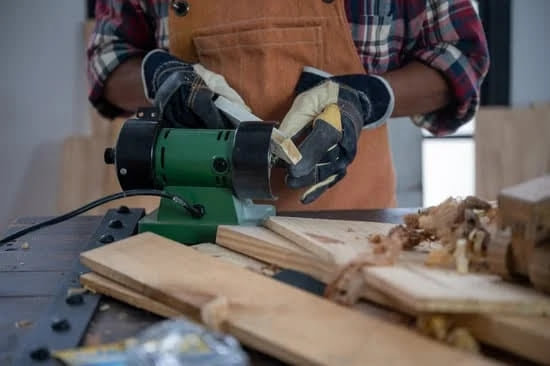Designing a home woodworking shop is an exciting and challenging endeavor for any woodworker. The creation of a well-designed space is essential for maximizing efficiency, productivity, and safety.
In this article, we will explore the key factors to consider when designing a home woodworking shop, including assessing available space, essential tools and equipment, layout design, storage solutions, safety measures, personalization, and budgeting. Whether you are a beginner or seasoned woodworker, creating a functional and organized workshop can significantly enhance your woodworking experience.
When it comes to creating a home woodworking shop, one of the most crucial aspects is understanding the importance of a well-designed space. A thoughtfully laid out workshop not only makes the work more efficient but also provides a safe environment for carrying out woodworking activities. It’s important to carefully plan and consider all elements that will contribute to the overall functionality of your home workshop.
In the upcoming sections of this article, we will delve into the process of designing a home woodworking shop step-by-step. From assessing available space to ensuring safety measures and incorporating personal touches, this comprehensive guide will provide valuable insights into creating an ideal workspace for all your woodworking endeavors.
Whether you have limited space or are working within a specific budget, there are tips and tricks that can help you optimize your home woodworking shop without compromising on quality or safety.
Assessing Available Space
When it comes to designing a home woodworking shop, one of the most important factors to consider is the available space. The location of your workshop can have a significant impact on the functionality and efficiency of your woodworking activities. Here are some key considerations for assessing and determining the best location for your home woodworking shop.
Understanding Your Needs
Before settling on a specific location for your woodworking shop, it’s essential to assess your needs and requirements. Consider the size of your projects, the type of tools and equipment you’ll be using, and any additional space needed for storage and work areas. This will help you determine how much space is necessary for your workshop and narrow down potential locations within your home.
Optimizing Layout and Accessibility
The layout of your home woodworking shop should allow for easy access to tools, materials, and work areas. Consider locating your workshop near a garage or outdoor entrance for convenient transportation of lumber and equipment. Additionally, ensure that there is sufficient room for maneuvering large pieces of wood and operating power tools safely.
Noisy Environments
Woodworking can create significant amounts of noise, so it’s important to consider the impact on other members of your household or neighbors. If possible, choose a location that minimizes disturbances to others while still providing adequate space for your woodworking activities.
By carefully assessing available space and considering these factors, you can determine the best location for your home woodworking shop that meets your needs while minimizing disruptions to others in your home or neighborhood.
Overall, crafting an efficient yet comfortable environment in which to execute one’s projects is necessary when deciding where to place one’s equipment. Even within small homes or apartments housing constraints may quickly become an issue within creating rooms dedicated towards engaging with this craft via storage concerns as well as convenience through ease-of-access concerns.
Essential Tools and Equipment
When setting up a home woodworking shop, one of the most crucial steps is determining the essential tools and equipment needed for a functional space. Whether you are a beginner or an experienced woodworker, having the right tools can significantly impact the quality of your work and overall efficiency.
Some must-have items for a woodworking shop include a table saw, miter saw, router, drills, chisels, and clamps. These tools form the foundation of any woodworking shop and are essential for various tasks such as cutting, shaping, drilling, and assembling wood.
In addition to power tools, hand tools are also essential for any woodworking shop. Tools like hammers, screwdrivers, hand saws, levels, and measuring tapes are indispensable for precise measurements and fine-tuning details in woodworking projects. It’s important to invest in high-quality tools that will last longer and provide better results. While it may require an initial investment, having reliable tools will ultimately save time and money in the long run.
Apart from the tools themselves, safety equipment is equally important in a home woodworking shop. Safety glasses, hearing protection, dust masks or respirators are necessary to protect yourself from potential hazards while working with wood.
Additionally, having a first aid kit readily available in your shop is essential in case of any accidents or injuries. By prioritizing essential tools as well as safety equipment when designing your home woodworking shop can set you up for success in pursuing your passion for woodworking.
| Tools | Importance |
|---|---|
| Table Saw | Essential for making accurate cuts on large pieces of wood. |
| Miter Saw | Ideal for making crosscuts on lumber quickly and accurately. |
| Router | Used for hollowing out an area in the face of a relatively hard workpiece. |
Designing the Layout
When it comes to designing the layout of your home woodworking shop, the goal is to maximize efficiency and productivity in the space. One of the most important considerations is the workflow within the shop. You’ll want to arrange your tools and equipment in a way that makes sense for the type of projects you’ll be working on. This might involve creating specific zones for cutting, sanding, assembly, and finishing.
Another key aspect of designing the layout is ensuring that you have adequate space to move around and work comfortably. You’ll need to factor in the dimensions of larger tools and workbenches, as well as leave room for material storage and waste disposal. It’s also important to consider the positioning of windows and lighting to ensure proper visibility during detailed work.
In addition, when planning your layout, it’s essential to take into account any future expansion or changes you may want to make. Flexibility in your design can save time and money down the road if you decide to add new equipment or reorganize your space. By carefully considering these factors, you can create a well-organized and functional woodworking shop tailored to your specific needs.
Remember when designing your home woodworking shop’s layout that maximizing efficiency and productivity involves thoughtful planning and organization. Be sure to take into account workflow, available space, flexibility for future changes, and visibility when arranging your tools and equipment within the space. With a well-designed layout, you can enhance your woodworking experience and make the most out of your home workshop.
Storage Solutions
When creating a home woodworking shop, organizing and storing wood, tools, and supplies is crucial for maximizing efficiency and productivity. One of the first steps in designing your workshop is to consider how you will store various materials and equipment to keep the area safe and clutter-free. There are several storage solutions that can help you make the most of your space while keeping everything readily accessible.
One popular storage solution for woodworking shops is wall-mounted tool racks or pegboards. These allow you to hang hand tools such as saws, hammers, chisels, and screwdrivers within easy reach. Additionally, installing shelving units or cabinets can provide valuable storage for power tools, hardware, safety equipment, and finishing supplies. Keeping these items off the floor not only prevents accidents but also frees up more space for working on projects.
Another essential aspect of an organized woodworking shop is lumber storage. Utilizing vertical lumber racks or horizontal lumber bins can help you keep various wood types neatly organized and easily accessible for your projects. For smaller scraps of wood, consider using stackable containers or a designated scrap bin to avoid creating unnecessary clutter in your workspace.
Properly organizing and storing wood, tools, and supplies in your home woodworking shop not only makes it easier to find what you need but also helps maintain a safe environment for woodworking activities. By implementing effective storage solutions, you can create a well-organized workshop that enhances both functionality and safety.
| Storage Solution | Description |
|---|---|
| Wall-Mounted Tool Racks/Pegboards | Allows for easy access to hand tools while keeping them off the workbench. |
| Shelving Units/Cabinets | Provides storage for power tools, hardware, safety equipment, finishing supplies. |
| Lumber Storage Solutions | Vertical/horizontal racks or bins for organizing various wood types. |
Safety Measures
When designing a home woodworking shop, prioritizing safety measures is crucial to ensure a secure environment for woodworking activities. Here are some essential safety measures to consider when setting up your woodworking space:
- Invest in quality personal protective equipment (PPE) such as safety goggles, ear protection, dust masks, and work gloves.
- Install proper ventilation in the workshop to reduce exposure to sawdust and harmful fumes from wood finishes and adhesives.
- Implement good housekeeping practices by keeping the workshop clean and clutter-free to prevent tripping hazards and fires.
- Ensure that all power tools are properly maintained and equipped with safety features such as blade guards and emergency shut-off switches.
In addition to these measures, it’s important to have clear safety protocols in place for using machinery and handling sharp tools. Providing training on safe woodworking practices for anyone who will be using the shop is also crucial.
Another important consideration for ensuring a safe environment in your home woodworking shop is proper fire prevention. This can include having a fire extinguisher readily available, storing flammable materials in designated areas away from heat sources, and installing smoke detectors.
Lastly, one of the most critical safety measures is to always be mindful of proper ergonomics when working in the shop. This includes setting up workbenches at the correct height to avoid strain on your back and joints, as well as taking regular breaks to prevent fatigue and maintain focus.
By prioritizing these safety measures in your home woodworking shop design, you can create a secure environment that promotes productivity while minimizing the risk of accidents or injuries.
Personalizing Your Workshop
When it comes to designing a home woodworking shop, adding personal touches and customization can truly make the space your own. Whether you are a professional woodworker or a hobbyist, incorporating elements that reflect your style and preferences can enhance your overall experience in the workshop. Here are some ideas on how to personalize your woodworking space:
Custom Workbench
One way to add a personal touch to your home woodworking shop is by customizing your workbench. Consider adding built-in storage for tools, designing a surface that fits your specific needs, or incorporating a unique design element that reflects your personality. Personalizing your workbench can make it not only functional but also visually appealing.
Decor and Artwork
Adding decor and artwork to your woodworking shop can really liven up the space. Consider hanging up vintage woodworking tools, displaying finished woodworking projects, or incorporating motivational quotes related to woodworking. Personalizing the walls of your workshop can create an inspiring and inviting environment for all of your woodworking activities.
Tool Organization System
Personalize the organization of your tools by implementing a system that works best for you. Whether it’s labeling drawers and cabinets, color-coding tools, or creating custom tool holders, find organizational methods that fit with your workflow and preferences. This not only adds a personal touch but also enhances efficiency in the workshop.
By focusing on personalization in your home woodworking shop, you can create a space that is not only functional but also reflects who you are as a woodworker. From custom workbenches to personalized decor and organization systems, there are endless ways to make your workshop uniquely yours. Remember that personalization is key to creating an environment where you feel comfortable and inspired to pursue your passion for woodworking.
Budgeting and Cost-Effective Options
Designing a home woodworking shop doesn’t have to break the bank. With some careful planning and consideration, it is possible to create a functional and efficient workspace without spending a fortune. Here are some tips for budgeting and finding cost-effective options for your home woodworking shop:
- Consider purchasing used or refurbished equipment: Many woodworking tools and machinery can be found at a fraction of the cost when bought second-hand. Check online marketplaces, local classifieds, or even specialized stores that sell refurbished equipment.
- DIY your workbenches and storage solutions: Instead of buying expensive pre-made workbenches and storage units, consider building your own. There are plenty of DIY plans available online for building sturdy workbenches and storage shelves using basic materials.
- Look for sales and discounts: Keep an eye out for sales, promotions, and discounts on woodworking tools and supplies. Many hardware stores offer seasonal sales or clearance deals that can help you save money on essential items for your workshop.
In addition to these budget-friendly tips, it’s also important to prioritize your purchases. Start with the most essential tools such as a table saw, drill press, and sander before investing in more specialized equipment. By carefully considering your needs and taking a strategic approach to purchasing tools and equipment, you can design a well-equipped woodworking shop without breaking the bank.
Remember to also factor in ongoing costs such as maintenance, tool sharpening, and consumables like sandpaper and glue. By accounting for these expenses in your budget planning, you can ensure that your home woodworking shop remains functional and efficient in the long run.
Conclusion
In conclusion, creating a well-designed home woodworking shop can greatly enhance the quality of your work, as well as your overall woodworking experience. By carefully assessing available space, selecting essential tools and equipment, optimizing layout and storage solutions, prioritizing safety measures, personalizing your workshop, and budgeting effectively, you can ensure that your woodworking shop meets all your needs while fitting within your means.
A well-functioning and organized workshop not only makes it easier to work on projects but also helps prevent accidents by ensuring that tools are stored safely and work areas are clear. With a thoughtfully designed space, you can streamline your woodworking activities, making them more enjoyable and efficient. This will ultimately allow you to focus on the creative and fulfilling aspects of woodworking rather than being frustrated by a disorganized or unsafe workspace.
In the end, investing time in planning and designing a home woodworking shop will undoubtedly pay off in the long run. It is essential to remember that the ultimate goal is to create an environment where you can enjoy pursuing your passion for woodworking safely and efficiently.
By following the tips provided in this article on how to design a home woodworking shop, you can ensure that your workshop becomes a space where you can bring all your creative visions to life.
Frequently Asked Questions
How Do You Plan a Woodworking Workshop?
Planning a woodworking workshop involves considering the space available, the types of projects to be undertaken, and the necessary tools and equipment. It’s important to create a detailed layout of the workshop, including workbenches, storage for materials and tools, and any specialty areas such as a finishing or sanding station.
Safety should also be a top priority when planning a woodworking workshop, so ensuring there is proper ventilation, lighting, and fire safety measures in place is essential.
How to Set Up a Wood Shop at Home?
Setting up a wood shop at home requires careful consideration of available space and budget. It’s important to start with the basics, such as essential tools like saws, chisels, and planes, as well as workbenches and storage solutions.
Organizing the space efficiently is key to maximizing productivity in a home wood shop. Additionally, considering noise control for neighbors and dust collection are important aspects to consider when setting up a wood shop at home.
How Do You Design a Workshop Layout?
Designing a workshop layout involves thinking about workflow and efficiency in the space. This includes strategically placing workbenches and tools for easy access while also leaving enough room for movement between stations.
Considering natural light sources when positioning work areas is also important for visibility during detailed tasks. The layout should also allow for future expansion or addition of new tools or equipment as woodworking skills grow over time.

Hi everyone! I’m a woodworker and blogger, and this is my woodworking blog. In my blog, I share tips and tricks for woodworkers of all skill levels, as well as project ideas that you can try yourself.





